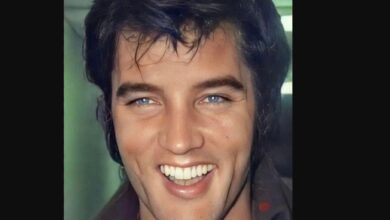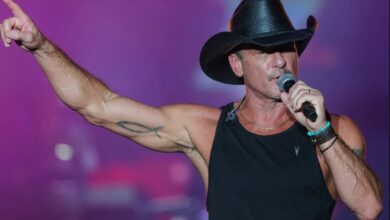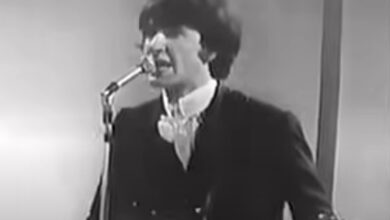Taylor Swift and Mick Jagger’s Nashville Surprise Proves the Boundless Power of Pop Stardom
If we truly are known by the company we keep, then Taylor Swift sent a powerful message in Nashville on September 26, 2015, when she stunned a sold-out crowd at Bridgestone Arena by welcoming none other than Mick Jagger to the stage. With a roar from the crowd, the legendary Rolling Stones frontman joined Swift for a scorching rendition of “(I Can’t Get No) Satisfaction,” creating a moment that electrified the 15,000 in attendance and rippled across social media for days. It was more than just a duet—it was a high-voltage collision of musical generations, and proof of the cultural influence Swift now commands.
Taylor Swift’s evolution from teenage country darling to global pop juggernaut has been anything but accidental. Born in Pennsylvania and raised in Tennessee, she broke into the Nashville scene with songs rooted in small-town heartbreak, but always with a sharp ear for melody and universal emotion. As she transitioned into pop, Swift not only retained her storytelling instincts—she amplified them, combining bold visuals, massive productions, and unfiltered vulnerability into an empire that reached far beyond her original genre.
Bringing Jagger onstage wasn’t just a showbiz stunt—it was a symbolic gesture. Here was Swift, a woman in her mid-20s, commanding enough clout to pull one of rock’s most iconic voices onto her stage, in her city, on her terms. Whether he flew in from London specifically for the moment or was just passing through, no one could deny the sheer magnitude of it. Nashville hadn’t seen the Glimmer Twin since the Stones’ LP Field performance months prior. Now, here he was again, summoned like a rock god cameo in Swift’s arena-sized pop temple.
The show itself, part of Swift’s 1989 tour, was a masterclass in arena production. She opened with “Welcome to New York,” strutting in sunglasses and a glittering jacket, surrounded by a cadre of dancers that looked plucked from a sci-fi dream. The LED screens flashed noir-style images of Manhattan, evoking Gatsby’s lost glamour with a modern, electric twist. Swift’s dream of New York wasn’t just a place—it was a mythic space for reinvention, where heartbreaks are tucked away like letters in a drawer and every skyline gleam holds the promise of new beginnings.
Moving into her second number, “New Romantics,” she tossed off her jacket mid-song, revealing a sleek black halter top and igniting screams from the audience. It was just one of many outfit changes that night, each punctuating a shift in theme or emotion. Every costume, light cue, and dance move was part of a larger narrative—one where Swift wasn’t just performing songs, she was performing versions of herself.
What truly sets Taylor Swift apart, however, is her uncanny ability to connect with her audience. The high-pitched shriek that greeted her arrival wasn’t just admiration—it was familiarity. She recognized fans from Instagram posts. Her father, spotted in the crowd before the show, was approached like a celebrity himself. Swift’s gift is in making every fan feel seen, as though their stories and heartbreaks are part of her own narrative tapestry.
Testimonials from Swift’s high-profile “squad” were interspersed throughout the concert—cameo videos from Lena Dunham, Karlie Kloss, Lily Aldridge, and Selena Gomez played between songs. But unlike other celebrity entourages, Swift’s crew wasn’t framed as unattainable. Instead, they were cast as relatable co-stars in a fantasy of female friendship, success, and glittering possibility. It wasn’t just a concert—it was a lifestyle campaign.
One of the most tender moments came when Swift performed “Fifteen” acoustically, dedicating it to her real-life best friend Abigail and giving a heartfelt nod to her roots at Hendersonville High School. In doing so, she closed the loop between small-town beginnings and global superstardom. No matter how far she’s traveled from country music’s traditional turf, Swift still knows exactly how to ground a moment in something intimate and true.
Mick Jagger’s presence elevated the show, but it didn’t define it. Rather, it was a perfectly timed exclamation point—an unscripted burst of rock ‘n’ roll energy that reinforced the fluidity of genres and generations. It reminded the crowd that while Swift may have left country behind, she hasn’t abandoned her musical curiosity or her appreciation for legacy. And in that way, she continues to challenge and stretch the boundaries of what pop music can hold.
Midway through the night, Swift addressed the crowd in a vulnerable monologue about criticism, fame, and staying true to oneself. With tears brimming, she encouraged fans to shake off the labels others try to give them. “If anyone tells you you are uncool, they’re wrong,” she said. In that moment, she wasn’t just a performer—she was a mirror for every young person in the audience still trying to define who they are.
Tickets for the show weren’t cheap—some floor seats hit $2,000 on StubHub—but the packed arena reflected more than just wealth. Families, teenagers, fathers, and die-hard fans all came together in a shared, emotional experience. Whether through her lyrics, her speeches, or her showmanship, Swift managed to make each person feel like they belonged.
And that’s ultimately the core of Taylor Swift’s appeal. Her shows are less about spectacle (though there’s plenty of that) and more about shared emotion. Whether she’s dancing with Victoria’s Secret models, duetting with a rock legend, or singing about a lost high school friendship, Swift weaves moments that feel both massive and personal.
Her Nashville performance—and Jagger’s appearance within it—wasn’t just a highlight reel moment. It was a reflection of the cultural bridge she continues to build, one that connects past to present, country to pop, and icons to everyday dreamers. It proved once again that music, at its best, doesn’t just entertain. It invites us in, hands us a piece of its magic, and makes us feel like part of the story.



